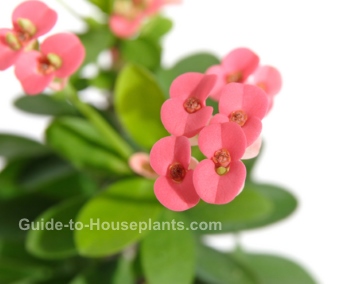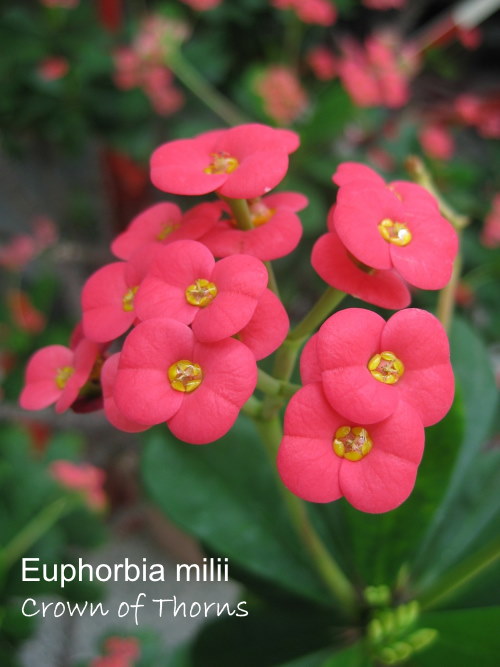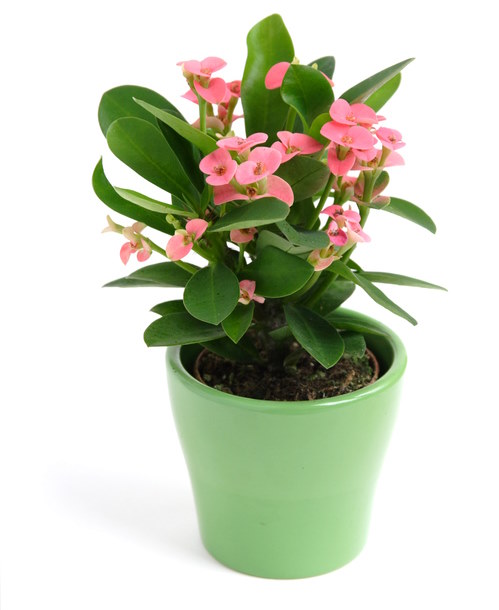Crown of Thorns Plant
Botanical Name: Euphorbia milii
Crown of Thorns plant is one of the rare succulents capable of blooming most of the year. It also happens to be one of the easiest to grow indoors, preferring the same warm conditions we do.
Bright-green leaves grow along its thick, thorny stems. Lower leaves naturally fall off as the plant ages -- and they won't grow back. If your plant gets too tall and leggy, you can prune it back by half its size in spring. This will cause it to branch out. New stems will grow from below where the pruning cuts were made, making this succulent bushy and full.

Its flowers are actually bracts that last for several weeks, with an ongoing show of color that lasts for months. Those bracts are available in bright pink, salmon, peach, red, white or yellow.
Today's hybrids produce more -- even bigger -- flowers than ever before. Crown of Thorns flower dependably when they get enough light. Spring and summer are usually the best seasons for an abundance of blooms. However, you can keep this unusual succulent blooming through fall with plenty of bright light.
Give Crown of Thorns a winter rest. Shorter daylight hours in fall will cause growth of the plant to slow down. Set your plant in a cooler spot (with sunlight) and water sparingly throughout the winter. (See "Temperature" and "Water" tips below.)
They're easy to grow and drought-tolerant, preferring slightly dry, sandy soil. This succulent stores water in its thick stems just like a cactus, so it can be watered less frequently than other house plants. If its leaves turn yellow and fall off, cut back on the watering.
CAUTION: Wear thick gloves when handling this plant -- those thorns are sharp! Also, watch out for its toxic, milky sap, which can irritate your skin, eyes and mouth.
 Plenty of sunlight will bring on the blooms. Photo by FuzzyDunlop
Plenty of sunlight will bring on the blooms. Photo by FuzzyDunlopCrown of Thorns Problems, Solutions and Answers
No flowers? If you just brought it home from the nursery, give it time. Young plants probably won't bloom until they are at least a year old. Spring is the strongest season for flowering. This tough succulent doesn't need a lot of encouragement to bloom -- if it's not blooming, it's not getting enough sunlight.
Yellow leaves? You over-watered. Those thick, succulent stems store water, allowing Crown of Thorns to go longer without a drink. Water less in the winter, while growth is slower.
Repot in spring, probably every couple years or when it's crowded in its pot. Use a pot just 1-2 inches larger than the old one, with a drainage hole to prevent soggy medium and root rot. Keep the base of the plant at the soil level, just as it was in the old pot; don't bury the stems or they'll rot. Larger shrubs can be top-dressed instead by replacing the top couple inches of potting mix with fresh mix.
Something bugging your plant? Watch for tiny insects around the growing tips. Aphids are attracted to new growth, sucking plant juices and excreting honeydew -- a sticky substance. Treat any infestation immediately because aphids cause damage to plants, multiply quickly, and may move on to your other houseplants.
 Photo Tamara Kulikova/istockphoto
Photo Tamara Kulikova/istockphotoCrown of Thorns Care Tips
Origin: Madagascar
Height: 2 ft (60 cm). Prune off growing tips to control plant's height.
Light: Bright light to full sun. Plants that don't bloom aren't getting enough light. Move Crown of Thorns to a sunny window where it gets about 4 hours of direct sun every day. Give it a quarter turn every week to expose all sides to sunlight to promote even growth. Don't have a sunny window? Set it under a grow light, if you want.
Water: Allow the top 1 in (2.5 cm) of soil to dry out between waterings. Water sparingly in winter when growth is slower. Also avoid getting water on the leaves and stems because they can rot if they get too wet. Yellow leaves that fall off are a sign the plant is over-watered.
Humidity: Average room (around 40% relative humidity).
Temperature: Grows best with average room temperatures 65-75°F/18-24°C; a cooler winter rest (with a minimum of 55°F/13°C) will help promote flowers in spring and summer. If you move your plant outdoors for the summer, don't worry -- it can take the heat. Crown of Thorns will tolerate temps up to 90°F/32°C.
Soil: A fast-draining medium such as cactus potting mix works best.
Fertilizer: Feed every 2 weeks spring through fall with a balanced water-soluble fertilizer diluted by half. Don't feed in winter, when flowering is over.
Propagation: Propagating from tip cuttings is easy, if you don't stick your fingers with the sharp thorns! Take 3 in (7.5 cm) stem cuttings in spring or summer. Dip the cut ends in warm water for a few minutes to stop the flow of sap then allow to dry for 24 hours before inserting into barely moist potting mix. Cuttings will root in about 6 weeks.


